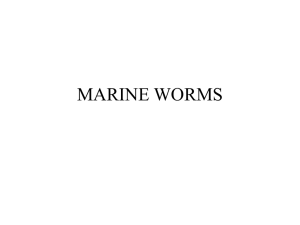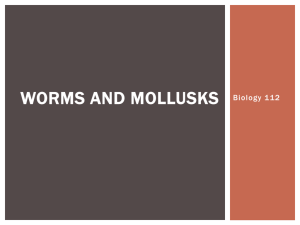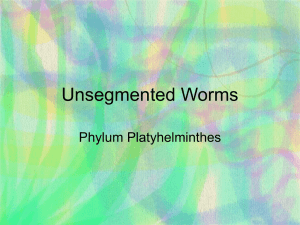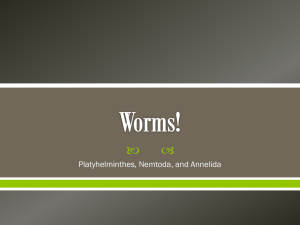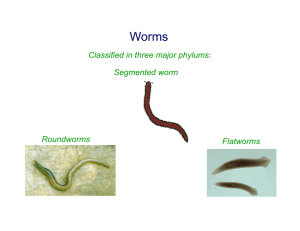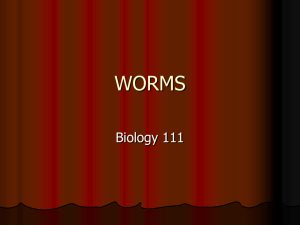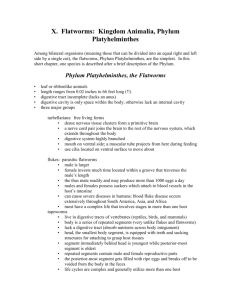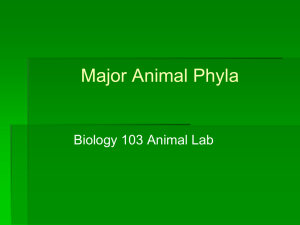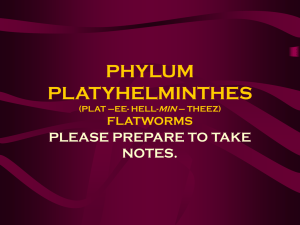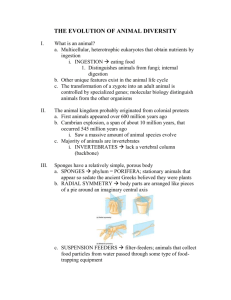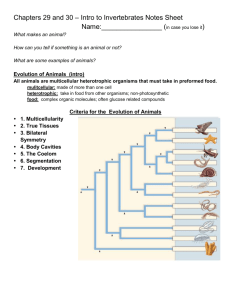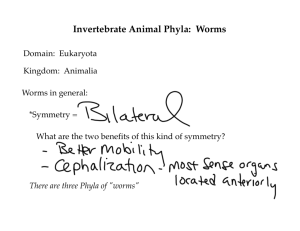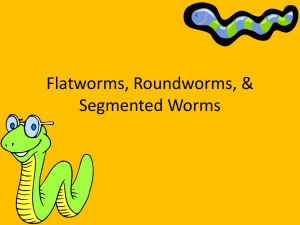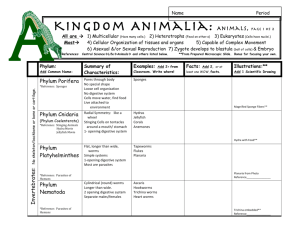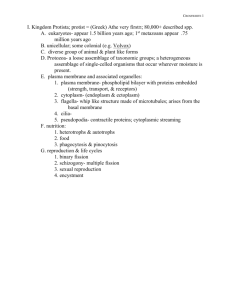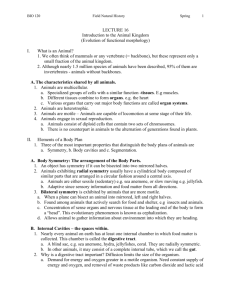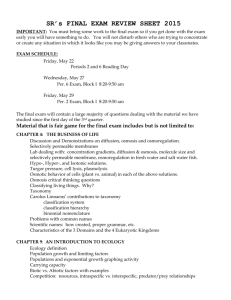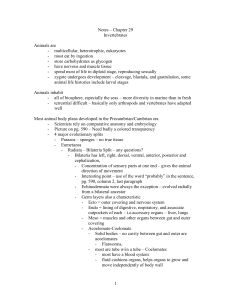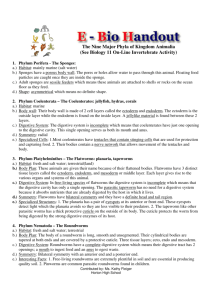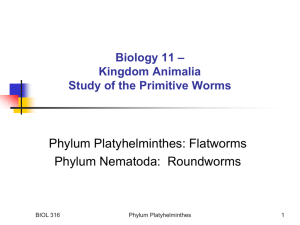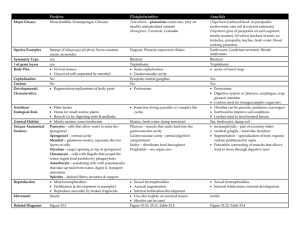Major Division in the Animal Kingdom
advertisement
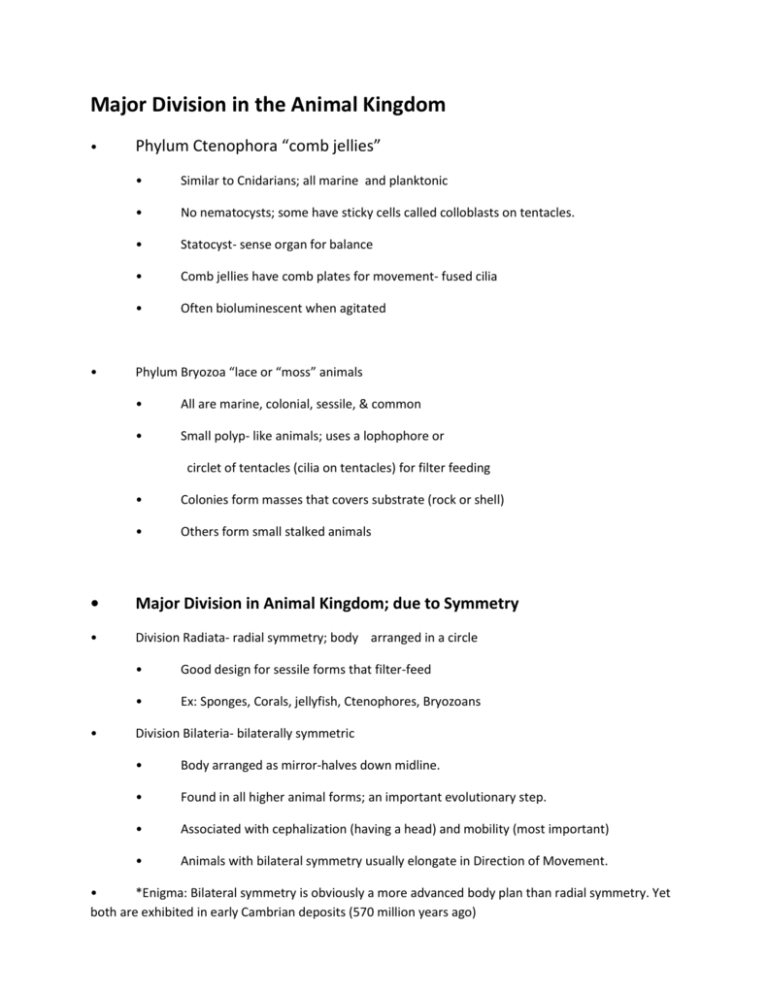
Major Division in the Animal Kingdom • • Phylum Ctenophora “comb jellies” • Similar to Cnidarians; all marine and planktonic • No nematocysts; some have sticky cells called colloblasts on tentacles. • Statocyst- sense organ for balance • Comb jellies have comb plates for movement- fused cilia • Often bioluminescent when agitated Phylum Bryozoa “lace or “moss” animals • All are marine, colonial, sessile, & common • Small polyp- like animals; uses a lophophore or circlet of tentacles (cilia on tentacles) for filter feeding • Colonies form masses that covers substrate (rock or shell) • Others form small stalked animals • Major Division in Animal Kingdom; due to Symmetry • Division Radiata- radial symmetry; body arranged in a circle • • Good design for sessile forms that filter-feed • Ex: Sponges, Corals, jellyfish, Ctenophores, Bryozoans Division Bilateria- bilaterally symmetric • Body arranged as mirror-halves down midline. • Found in all higher animal forms; an important evolutionary step. • Associated with cephalization (having a head) and mobility (most important) • Animals with bilateral symmetry usually elongate in Direction of Movement. • *Enigma: Bilateral symmetry is obviously a more advanced body plan than radial symmetry. Yet both are exhibited in early Cambrian deposits (570 million years ago) • Embryological Cell Layers • Acoelomates- animals with 3 cell layers; with no coelom – Coelom means body cavity Ex: Flatworms and Ribbonworms • Ectoderm- skin, bones, nervous tissue • Endoderm- digestive system, viscera • Mesoderm- muscles • Coelomates- animals with a coelom that is lined with mesoderm – These animals have a digestive system with 2 openings ! • Phylum Platyhelminthes- the flatworms • Bilaterally symmetric; non-segmented • Can be marine, freshwater or parasitic • Two anterior nerve ganglia & two ventral nerve cords; some have eyespots • Incomplete digestive system (acoelomate); primitive excretory system called flame cells • No appendages; “like wet tissue paper”; glides across substrate on cilia that covers ventral surface • Marine forms – usually small, common, live under rocks, between sand grains; some tropical forms are brightly colored • 3 Classes – Turbellaria- free living forms • • Trematoda - the flukes (parasites) – • Ex: Planaria (freshwater) Ex: Liver and Blood flukes Cestoda - tapeworms – Ex: Diphillobothrium latum- can get from eating raw fish • Phylum Nemertina (Rhynchocoela)- the ribbon worms • Elongated, ribbon-shaped, “noodle-like”; can break apart easily • Live on bottom under rocks, shells, seaweed, • Move by gliding on trail of slime, or by muscular contractions • No segments or appendages • Have a complete digestive system; simple circulatory system; mouth on anterior end (not midventrally as in flatworms) • Size ranges from few inches to several meters • Have long, tongue-like proboscis well suited for capturing prey, defense and for burrowing • Proboscis is housed in a primitive body cavity called the Rhynochocoel • Carnivorous – eats small worms, molluscs, and crustaceans • Some are very colorful; often found around coral reefs • Pseudocoelomate- a “false” body cavity • Phylum Nematoda- roundworms 10,000 species • Body is cylindrical; pointed at both ends; covered by a cuticle for protection; size ranges from microscopic to 12 inches. Body form is almost identical between species. • Can be terrestrial, freshwater, marine, or parasitic; found in almost all environments. May be the most abundant animal on Earth! • Free-living forms are important members of food web by breaking down organic detritus (waste) • Pseudocoelomate- a “false” body cavity • Phylum Rotifer “Wheel worms” • Microscopic filter feeders • Body features: – Corona- twin bands of cilia; produces water current for feeding – Mastax- internal jaws; grinds up swallowed food – Retractable foot with “toes” for attachment – Pseudocoelomate- a “false” body cavity • Phylum Annelida- segmented worms 15,000 species • True- segmented worms; most highly developed of the worm-like invertebrates; includes the Earthworm (Class Oligochaeta), the leeches (Class Hirudinea), and marine fanworms (Class Polychaeta) • Body has segments called somites; both internal and external; evolutionary significance- forms a “hydrostatic skeleton” • Each segment (with a partition) can be used to change internal pressure. This results in conservation of energy and faster motion. • Have a circulatory system, nervous system, and a complete digestive system (coelomate) • Class Polychaeta • (meaning many bristles) is the most commonly encountered marine worm • Each segment has small “bristled” appendages on each side called parapodia- which aid in locomotion, respiration, and filter feeding • Some are free-swimming; most burrow or live in tubes, thus they can be called infaunal filter feeders • Live in sand, mud, under seaweed & rocks; or attached to pilings • Morphologically Diverse! range from simple to bizarre shapes • This class includes: fanworms, tubeworms, lugworms, and scaleworms • Trochophora larva • Ciliated larval form-planktonic - This larval form is found in flatworms, ribbonworms, annelids and molluscs. Because these various phyla have this larval form in their life cycles, suggest a common ancestor
